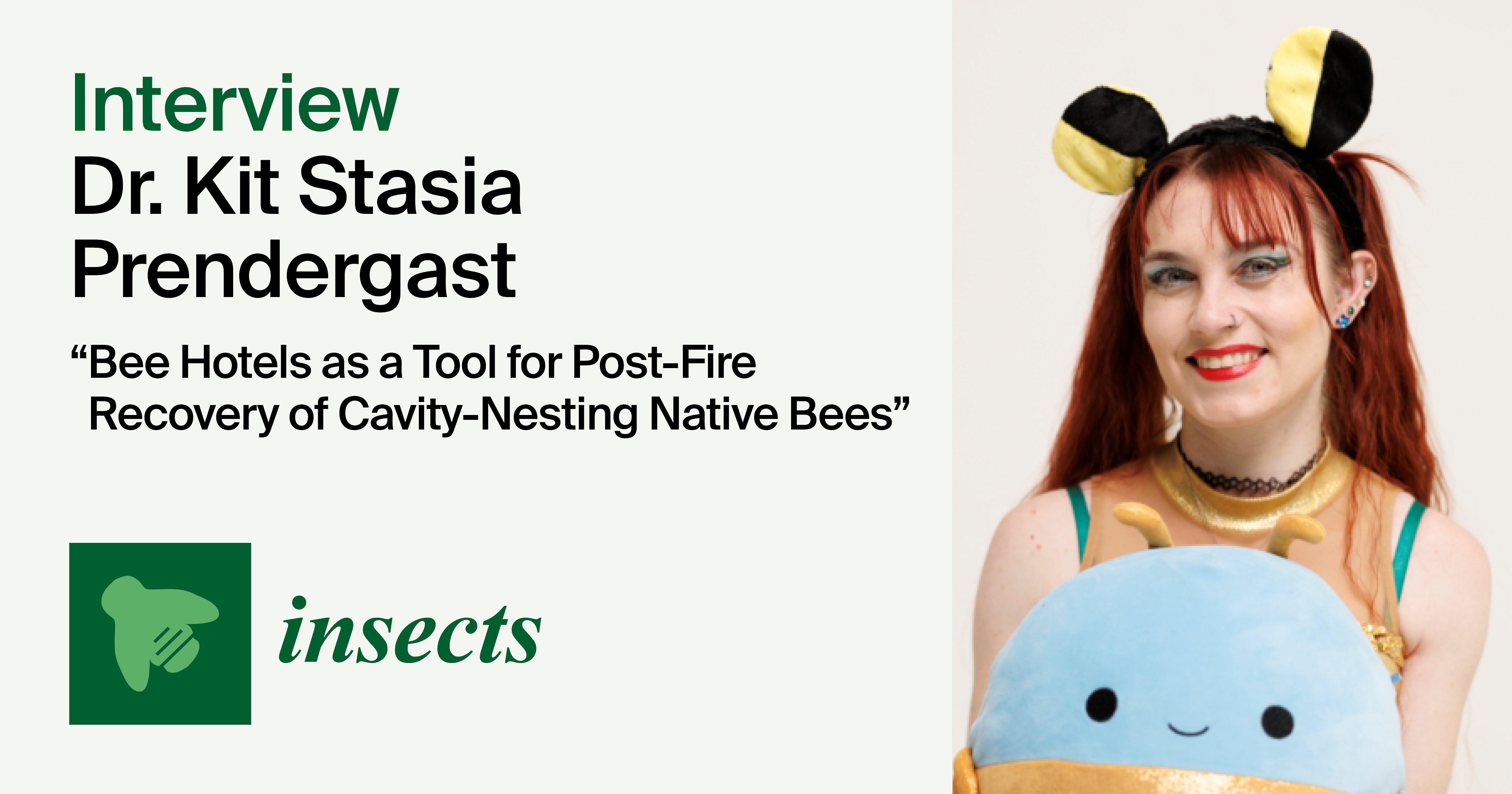Need Help?
5 August 2025
Insects | Interview with the Author—Dr. Kit Stasia Prendergast

We recently invited Dr. Kit Stasia Prendergast to share the story behind her paper, “Bee Hotels as a Tool for Post-Fire Recovery of Cavity-Nesting Native Bees”, featured as the Cover Story in Volume 16, Issue 7 of Insects (ISSN: 2075-4450). Through an email interview, she generously provided the following insights into her research, challenges, and personal journey.
1. Could you briefly introduce your paper?
This research was a world-first trial of using bee hotels—artificial nesting structures—as a tool to monitor recolonization of post-bushfire habitats by cavity-nesting bees, and by providing them with extra nesting structures, help with boosting their populations and aiding in their recovery after fires. I installed 1000 bee hotels of two different designs at five sites in the Jarrah Forest of southwest Western Australia that had been burnt in the Black Summer bushfires and monitored them from September to March. By the end of the monitoring period, over 830 nests were occupied. I additionally found that there were fewer native bees foraging at sites where I didn’t install bee hotels than the sites where I had. In addition, higher densities of the introduced European honeybee reduced the number of native bees foraging, and nests occupied. This research provides a proof-of-concept that bee hotels, when designed correctly, can aid in bushfire recovery of solitary cavity-nesting native bees, and that we need to exclude honeybees from habitats that have been subjected to fires to ensure that the recovery of native bees is not jeopardized.
2. How did you choose this topic?
I have dedicated my life to conserving native bees and identifying, through evidence, ways we can better conserve them. I had been increasingly concerned at how fires impact native bees in Australia. After the Black Summer Bushfires, the Federal Government put out grants for projects that would assist in the recovery of fauna and flora. To date, most bushfire recovery efforts focused on vertebrates and plants. I wanted to trial using bee hotels as a way to see if we could both assess the ability of native bees to recolonize areas after fires and help boost their populations by providing them with nesting substrates that can be predicted to be in short supply after fires.
3. Were there any challenges?
There are always challenges for native bee conservation, with the primary one being a lack of funding. I am very grateful that my Dad is a fantastic carpenter and helped me create custom designed bee hotels—the cheap ones sold in stores do more harm than good!
4. What do you consider the key innovation?
The only research in Australia on helping native bees recover after bushfires has been for Xylocopa aerata on Kangaroo Island (another very important project). Native bees, however, as is typical, are neglected from most conservation actions. The key innovation was using bee hotels, that I had already demonstrated will be colonized by native bees, and installing them at a large scale to test recolonization and recovery in post-fire landscapes. How honeybees impact native bees in postfire landscapes has also not been studied.
5. How did you collect and analyze the data?
I drove at least 4 hours each day to each site in the Jarrah Forest to first install the 1000 bee hotels and then monitor them monthly from September until March. It is a beautiful landscape, even when charred by fires. I recorded how many holes in the bee hotels were occupied each month, and by what organisms. I also spent 2 hours recording native bees and honeybees on the recovering flowering plants around the sites, and at three sites within the same biogeographic region that were burnt, but I did not install bee hotels.
6. How long did the writing process take?
I had a strict deadline for the report to the Federal Government and submitted the report in July 2022. However, turning a report into a peer-reviewed publication takes much longer, and as the grant did not include funding for this component, it meant it had to take a back-seat, unfortunately, and I just had to chip away whenever I had “spare time” (ha!). Hence why I was not ready to submit the publication to Insects until this year (2025).
7. Tools/software helpful during the research and writing stages?
Just your standard Microsoft Word and R statistical program.
8. How do you manage your time between research and daily life?
That is the biggest challenge! I gave birth to my daughter Sapphire, a preemie baby, on Boxing Day 2024, and so my life has become even more busy (but in a beautiful way)! I also have, in addition to my “job” as a postdoc, many other projects on the side, including managing the Facebook group “The Buzz on Wild Bees”, SciComm on my Instagram account @bee.babette_performer, looking after my pets, performing circus acts, and spending time with my fiancé Matt. I’m very grateful I have such a supportive partner who will look after our baby for a few hours in the evening so I can do some solid work. Bees are both my research, and my “life”, so they are very much on my mind at all times! Do something that you love, follow your passions, and whilst there are certainly some aspects of research life that are trying (responding to Reviewer 2 haha!), it means you can fill your life with purpose, but always make sure that you have time for the things that really matter (family, keeping fit, spending time in nature).

